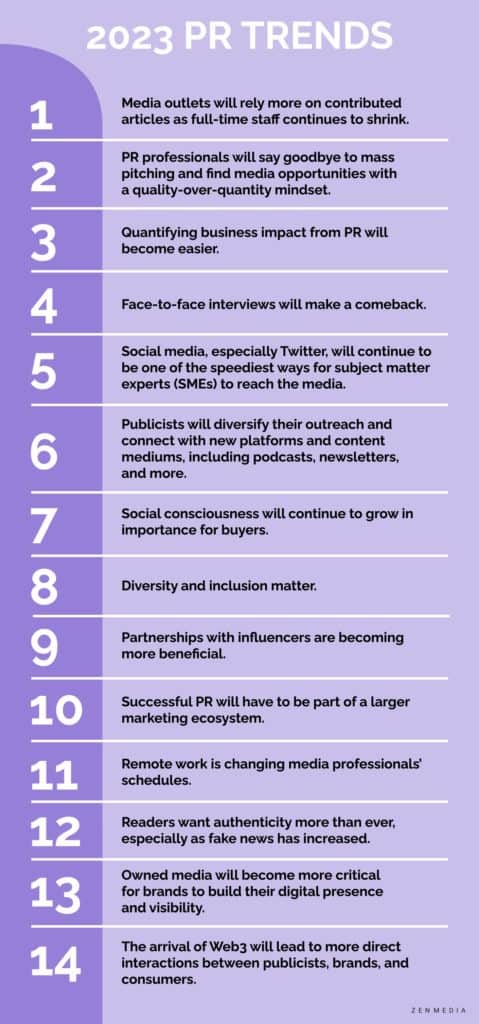After 2020’s massive shake-up, followed by a still-unpredictable 2021 and a looming recession in 2022, PR pros across all industries have had to adapt, evolve, and pivot to satisfy upcoming PR trends and get their client brands in the spotlight.
Combine this with ongoing changes in buying behavior, the persistence of remote work schedules, and global threats like the growth of fake news and misinformation on social media platforms, and 2023 will surely be a year to remember—albeit not, one hopes, anywhere near as much as the ones we’ve all just gone through.
So without further ado, here are the Zen Media team’s predictions for the PR trends we’ll see this coming year.
What PR trends are in store for the industry in 2023?
- Media outlets will rely more on contributed articles as full-time staff continues to shrink.
- PR professionals will say goodbye to mass pitching and find media opportunities with a quality-over-quantity mindset.
- Quantifying business impact from PR will become easier.
- Face-to-face interviews will make a comeback.
- Social media, especially Twitter, will continue to be one of the speediest ways for subject matter experts (SMEs) to reach the media.
- Publicists will diversify their outreach and connect with new platforms and content mediums, including podcasts, newsletters, and more.
- Social consciousness will continue to grow in importance for buyers.
- Diversity and inclusion matter.
- Partnerships with influencers are becoming more beneficial.
- Successful PR will have to be part of a larger marketing ecosystem.
- Remote work is changing media professionals’ schedules.
- Readers want authenticity more than ever, especially as fake news has increased.
- Owned media will become more critical for brands to build their digital presence and visibility.
- The arrival of Web3 will lead to more direct interactions between publicists, brands, and consumers.
PR Trends Shaping the Industry in 2023
1. Media outlets will rely more on contributed articles as full-time staff continues to shrink.
Since 2008, newsroom employment in the U.S. has fallen 26%, even as the demand for online content has grown exponentially. With only 7.4% of U.S. journalists today considering their role extremely important, newspaper staffs continue to shrink.
This means that media outlets have fewer full-time writers to rely on to satisfy that demand. As a result, the writers they do have are often relegated to breaking news or more complex topics—areas where freelancers aren’t as workable a solution.
What this means for the PR industry is that there is also more demand for contributed articles by outside authors—i.e., the kind of thought leadership that is so effective with B2B buyers.
If you’ve been struggling to convince your executive team to invest the time and effort required for strong B2B thought leadership, 2022 should be your year to change this.
While it may make sense to begin with smaller or local outlets, plenty of tier-one publications are hungry for contributed articles by experts as well. Entrepreneur, the Harvard Business Review, Mashable, and Fast Company are just a few examples.
If you’re handling PR for your B2B brand, you’ll want to get at least one member of your executive team on the thought leadership bandwagon, and then go hard on pitching throughout the year.
2. PR professionals will say goodbye to mass pitching and find media opportunities with a “quality-over-quantity” mindset.
In the old days, publicists would send their clients’ press releases to anybody and everybody who would read them. To increase the odds of gaining a press hit, professionals would produce and send mass emails to every publication imaginable—many of which were not necessarily aligned with their clients’ products or target audiences.
Related reading: 5 Tips for Writing Press Releases that Aren’t Boring + A Bonus PR Template!
In 2023, PR professionals will say goodbye to the mass pitching strategies of the past. Instead of crossing their fingers and hoping for the best, publicists will pitch and produce stories that are tailored to their clients’ products and demographics. These compelling pieces will then be sent to media outlets that are within the brand’s industry. Niche marketing will play a big role in this quality-over-quantity mindset.
3. Quantifying business impact from PR will become easier.
The ROI on B2B PR efforts has historically been difficult to quantify.
Outlets can offer information like their number of monthly unique visitors, ad impressions, etc., but that doesn’t really offer the full data picture that brands are looking for. Brands want to know how their PR efforts are actually changing brand perception, convincing clients to make purchases, and increasing loyalty, among other metrics.
Thanks to PR analytics tools, these things are becoming easier to measure.
But the tools alone won’t fix everything. Brands and their PR agency or staff must begin with strong KPIs so they know what they actually want to measure, and how important each metric is to their stated business goals.
In addition, utilizing digital PR as part of a bigger, integrated marketing approach (which every brand should be doing anyway) gives brands more analytical context to work with—instead of looking at PR metrics alone, they can see how that data fits into their larger marketing analytics picture.
4. Face-to-face interviews will make a comeback.
Is anyone really going to miss all those Zoom calls?
In 2023, reporters and media outlets are going to bring back the face-to-face interview wherever possible. This PR trend is especially true when it comes to in-depth features, profiles, and discussions of nuanced or controversial topics: you simply get a whole lot more from a person when you’re talking to them face-to-face.
Of course, Zoom interviews and phone calls will still be widespread, just as they’ve always been for sources for whom face-to-face is impractical or impossible. But brands should be prepared for more requests for in-person interviews and do their best to make their team available for those as much as possible.
5. Social media, especially Twitter and LinkedIn, will continue to be one of the speediest ways for subject matter experts (SMEs) to reach the media.
Think of this as the continuation of a PR trend that’s been ongoing for years now. If you want to reach a media professional quickly, head to Twitter. Despite its well-documented issues with toxicity and negativity, the platform remains one of, if not the, fastest way to convey timely information or breaking news about your brand to the press at large.
Related post: How to Keep the Momentum Going on a Successful B2B PR Campaign
LinkedIn is another versatile and useful platform for business professionals to utilize. It is powerful in the B2B space, where executives can highlight their industry thought leadership for their peers to see. In addition, LinkedIn can help B2B brands develop professional relationships with the media and fellow professionals in their sector.
Twitter is also highly useful for PR professionals looking for opportunities. Reporters, writers, video creators, and bloggers often post on the platform when they’re in need of new pitches or sources for a story they’re working on.
6. Publicists will diversify their outreach and connect with new platforms and content mediums, including podcasts, newsletters, and more.
As the nature of PR opportunities available continues to evolve and change, PR pros will continue to use more varied channels to identify the right ones for their clients.
From Muck Rack, to Help a Reporter Out (HARO), to Twitter, to Slack channels for media outlets, it’s easier than ever now for reporters to request expert sources and for PR pros to respond and pitch via a plethora of new emerging platforms and channels.
One of the greatest things about the rise of podcasts over the past several years is that there is truly a podcast for every audience. Is your client an expert in construction technology? There’s a podcast for that. Can they speak expertly about issues in the biological sciences? There’s one for that too.
These podcasts may not have huge numbers in terms of listeners or subscribers because they are about very specific, niche topics. However, their audience members will be highly engaged and interested in the topic at hand.
Newsletters are another great way for companies to build brand awareness with the individuals who would have the most interest. Whether you’re launching your own or receiving a mention in another company’s monthly email, you’ll want to highlight your expertise and value through every line of copy. Stay on a consistent schedule of publishing your newsletters and provide different insights in every edition. This new PR medium is a great way to promote your products to the people who need them the most.
Related post: LinkedIn Is All In On Newsletters—Are You?
Think of it in terms of macro influencers versus micro-influencers. The macro-influencers’ posts will be seen by many, and engaged with by few, while those from micro-influencers will be seen by fewer people, but those people are far more likely to want to engage with the brands those influencers are working with. The same is true for niche podcasts and newsletters.
These PR trends are what digital transformation looks like in PR. In effect, social media is the new crowdsourcing tool that every PR professional should be leveraging.
7. Social consciousness will continue to grow in importance for buyers.
Data supports the idea that buyers, both B2C and B2B, think companies need to have a strong social conscience.
Recent polling shows that 46% of people believe that companies need to take more responsibility for their role in society, with 55% of people saying they’re more likely to make a purchase from a company that shows empathy.
At the same time, those buyers are demanding that companies go beyond paying lip service to social causes and back up what they’re saying through real action—not just donating money or talking about their chosen causes once a year.
Brands that haven’t clearly communicated the social values that are important to them will need to remedy this quickly in order for PR efforts in 2023 to be successful.
Related post: 5 Steps to Developing an Outstanding Brand Voice on Social Media
Most buyers aren’t willing to offer brands the benefit of the doubt anymore. They want to know that the companies they work with are doing the hard work of actually living by the values they profess, even—and especially—when it’s inconvenient to do so.
8. Diversity and inclusion matter.
The longstanding failure of most corporate diversity and inclusion programs to deliver real change—a fact which was brought to the forefront during and has become even more apparent after the social and political upheaval of 2020—has left many buyers extremely skeptical of “Our commitment to diversity” statements.
Brands that want to keep loyal customers and attract new ones—especially Millennials and Gen Z, who now make up more than 60% of B2B buyers—will need to ensure that they can back up any diversity and inclusion statements they make, especially in the media, with real results. Any attempts, real or imagined, by brands to use their diversity and inclusion policies merely as PR fodder will backfire.
9. Partnerships with influencers are becoming more beneficial.
Brands have lagged when it comes to B2B influencer marketing, but this strategy can actually be extremely beneficial for brands in this sphere.
Why? Because reputation and referrals matter even more in B2B than they do in B2C.
If you can find an influencer who’s right for your brand—someone who speaks to the audience you need to reach, who’s deeply trusted by their followers, and who has high levels of engagement on an ongoing basis—partnering with them can work wonders for your PR efforts.
For one thing, you get the PR and marketing advantages that come simply through partnering in the first place, getting your brand out to the influencer’s audience, attracting new site visitors, and connecting with new potential clients.
For another, that influencer partnership will also build up your brand’s social proof. This is an important factor in B2B purchases, especially since the majority of B2B buyers begin their research by searching for potential vendors online.
10. Successful PR will have to be part of a larger marketing ecosystem.
PR has always worked better when combined with other B2B marketing efforts, but in 2023 this will be vital.
At Zen, our PR firm uses the term “the PR ecosystem.” In other words, PR is a piece of the marketing puzzle, but it needs to be combined with a strong content strategy, paid ads strategy, and social strategy.
This also means that any PR placements a brand gets need to be amplified.
Whether that looks like repurposing the hit into new, owned content, sharing it via social, or using it in an influencer campaign, amplification is a critical element of any PR strategy. Not doing so is truly a disservice to your business, as it means leaving so much in terms of potential results on the table.
Related post: The Critical Point Where Most PR Agencies Fail
11. Remote work is changing media professionals’ schedules.
This is a simple point, but an important one: just as going digital completely changed print newspapers’ deadlines and publishing schedules, remote work has upended some of the traditional rules about when and where to send pitches.
With journalists and creators working from home, some may well have changed their productive hours to outside the norm. This means that sending pitches between 10 a.m. and 2 p.m. (traditionally the ideal time to send) may no longer be the best move. The bottom line is that you’ll want to double-check any info journalists offer about when and how to reach them, and be ready to change your methods if necessary.
12. Readers want authenticity more than ever, especially as fake news has increased.
With fake news proliferating at an alarming rate, and infiltrating every facet of media, audiences are highly attuned to two things:
- Anything that feels insincere or “off”
- The anger and frustration that comes with being deceived
Authenticity has been a buzzword since social media allowed consumers and buyers to engage directly with the brands they purchase from, but it’s taken on new meaning since 2020.
Brands and PR pros must be acutely aware of this, so that they don’t accidentally allow one casual claim or insincere social post to generate resentment or suspicion among buyers and clients. Fact-check everything, and be prepared to back up any statements you make about your brand with evidence and results.
To go along with these PR trends, B2B companies in 2023 may want to take some time to reexamine their brand voice. Is it authentic to what you believe in and stand for? Does it need to evolve? Is it clear and defined across platforms? If you need help, check out 5 Steps to Develop an Outstanding Brand Voice on Social Media.
13. Owned media will become more critical for brands to build their digital presence and visibility.
You shouldn’t rely only on earned media to create a comprehensive PR strategy. Instead, shift gears and focus on creating owned media. This includes blog articles, newsletters, and social media posts on a brand’s personal channels. The goal of owned media is to reach a company’s desired audience organically, without the need for paid advertising. It is also fully controlled by the brand itself, which allows the brand to express its values and mission statement on its own terms.
PR professionals should not rely on journalists to bring their campaigns to life. Striking a balance between earned and owned media is essential in 2023. Not only will this give companies the freedom to create the content they want, but it will also boost B2B SEO and increase visibility on all platforms.
14. The arrival of Web3 will lead to more direct interactions between publicists, brands, and their consumers.
Marketers and tech professionals call Web3 the “future of the internet.” But what is it exactly, and how will it affect PR in 2023?
These four main points characterize this new era of the World Wide Web:
- Decentralization of data
- Immersive, virtual experiences
- An emphasis on user privacy
- Community building
As a result, publicists will be collecting consumer data with a more direct approach. This means having real-time conversations with their client’s prospects and present buyers via social media and community outreach channels like Discord. Web3 marketing will also lead publicists to try more immersive strategies to grab the media’s attention. This includes product trials and innovative digital events.
A recent article from Hackernoon sums up this concept:
“In the era of oversupply of products, brands must please users, not control them.” Drawing from this, Web3 PR is more people-oriented than Web1 and Web2 PR.”
2023 will be here before we know it. Is your brand ready for the coming PR trends? We can help.






